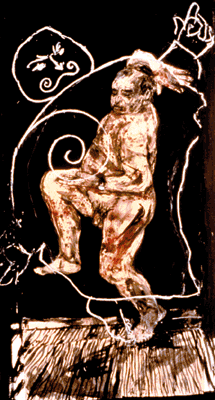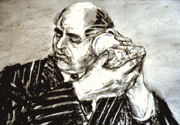
REVIEW
William Kentridge
through Jan. 20
MCA
220 E. Chicago Ave.
William Kentridge at the MCA
Poetic Interpretations of Post-Apartheid
By Kris Belden
 William Kentridge, one of the most celebrated artists to emerge from post-apartheid South Africa, mixes the poetic and the political to create art that's touching, serious and quite captivating. In his self-titled show at the Museum of Contemporary Art, Kentridge shows his viewers the aftermath of a country where hatred, racism and terror were moralized, and prejudice became law. Throughout his 25-year career, Kentridge, a 46-year-old white male, has explored every angle of morality's complex terrain, especially the element of racial guilt. His work proves that although apartheid has dissolved, the emotional and social implications are still very much present. William Kentridge, one of the most celebrated artists to emerge from post-apartheid South Africa, mixes the poetic and the political to create art that's touching, serious and quite captivating. In his self-titled show at the Museum of Contemporary Art, Kentridge shows his viewers the aftermath of a country where hatred, racism and terror were moralized, and prejudice became law. Throughout his 25-year career, Kentridge, a 46-year-old white male, has explored every angle of morality's complex terrain, especially the element of racial guilt. His work proves that although apartheid has dissolved, the emotional and social implications are still very much present.
Over the course of the past 12 years, Kentridge has created a completely original body of work using his unique take on animation: he makes short films by reworking charcoal drawings. The exhibit features 13 of these short films on monitors in dark alcoves and corner spaces, and displays more than 60 of the drawings used for the animation throughout the first floor galleries. The drawings stand as separate bodies of work unto themselves.
Of the drawings on view, one in particular, "Dancing Man" from 1998, encapsulates the ideas of memory, guilt and complicity that Kentridge consistently explores throughout his work. In this piece Kentridge depicts a portly, well-rendered pale white man dancing against a stark black background. A spontaneously sketched white line drawing of a large mustachioed male figure overlaps the dancing man, echoing his dancing movements. Kentridge's drawing is loose, sketchy and masterfully expressive. Both figures are flinging their arms in the air and are concentrating intently on dancing. At first glance, Kentridge's drawing appears whimsical and fun. The dancing men are big and clumsy. They look silly. It seems as though they are caught in the midst of a personal moment of celebration that no one was intended to see. However, upon closer examination, we see that Kentridge's message is actually very poignant. Neither man is smiling. Neither one meets our gaze. The main dancer is smeared and spattered with what appears to be traces of red blood. Both figures appear to be appropriating and enacting an African dance after a bloody victory.
Kentridge's drawings of the well-fed white men contrast dramatically against the stark black background, suggesting that white men stand for things that are foreign to South Africa. These men exist in great contrast to their environments. They represent the tyranny of apartheid and decades of devastating European colonization. The dancing men are representatives of the privileged white population, a group in which Kentridge is a member.
Although Kentridge's background influences our interpretation of his artwork, he specifically avoids overly descriptive titles ("Dancing Man," for instance, is a very general title) and overt narrative so that each viewer can find his or her own respective connections with the art. Subtlety is one of Kentridge's greatest strengths, and it keeps his art from appearing overly political and, therefore, easy to dismiss by those not affected first-hand by apartheid.
Kentridge also makes statements about the constancy of memory in this painting. In a few places, the artist revised his original white line drawings; the old white lines have been erased, but they are still visible. Like these lines, memories of apartheid and white South African guilt will never completely fade. Nobody was left with clean hands or a clear conscience, especially the privileged white population. And that includes the artist, who is said to have used himself as the model for "Dancing Man." Also, because the main dancing figure is rendered life-size, we identify with the dancer. This evokes a sense of consciousness within us. The artist suggests that all viewers - like Kentridge himself - also witnessed apartheid and had certain moral responsibilities to act. The artist implies that responsibility transcends national borders and involves all of humankind.
 The artist also makes another subtle statement about white guilt. The majority of American gallery-goers are white. By participating in the predominantly white art world, we are involved in an institution that is exclusive - racially and economically. The simple fact that Kentridge, whose race represents just 13 percent of his country's population, has been embraced by the art world as the representative artist for post-apartheid South Africa speaks to the white domination that exhibits like The Short Century, just upstairs from the Kentridge exhibit, hope to work against. However, Kentridge's political statements are not merely attempts to assuage his and the viewer's guilt. Having grown up in Apartheid South Africa, images of oppression and alienation became deeply embedded in Kentridge's psyche. His work shows such a great sensitivity and understanding of the irreversible hold of apartheid on humankind that he deserves every bit of the international success he's finally able to enjoy after two decades of working in near-isolation. The artist also makes another subtle statement about white guilt. The majority of American gallery-goers are white. By participating in the predominantly white art world, we are involved in an institution that is exclusive - racially and economically. The simple fact that Kentridge, whose race represents just 13 percent of his country's population, has been embraced by the art world as the representative artist for post-apartheid South Africa speaks to the white domination that exhibits like The Short Century, just upstairs from the Kentridge exhibit, hope to work against. However, Kentridge's political statements are not merely attempts to assuage his and the viewer's guilt. Having grown up in Apartheid South Africa, images of oppression and alienation became deeply embedded in Kentridge's psyche. His work shows such a great sensitivity and understanding of the irreversible hold of apartheid on humankind that he deserves every bit of the international success he's finally able to enjoy after two decades of working in near-isolation.
For more information call 312.880.2660, or visit www.mcachicago.org.
Images courtesy of MCA Chicago
|

